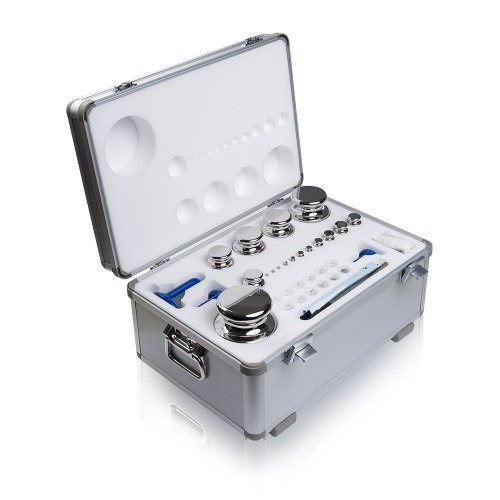When choosing non-magnetic stainless steel calibration weights, several factors should be considered to ensure their accuracy and suitability for your specific calibration needs. Here are some key points to consider:
Material Grade: Stainless steel comes in various grades, and it's crucial to select a grade that is non-magnetic. The most commonly used non-magnetic stainless steel grades for calibration weights are 304 and 316. These grades offer good corrosion resistance and non-magnetic properties.
Accuracy Class: Calibration weights are classified into accuracy classes based on their precision and tolerances. Determine the required accuracy class for your calibration process. Common accuracy classes include E1, E2, F1, F2, M1, and M2. Higher accuracy classes offer greater precision but are typically more expensive.
Weight Range: Determine the weight range you require for your calibration needs. Calibration weights are available in various sizes, ranging from milligrams to kilograms. Consider the weight increments needed for your specific application and ensure that the chosen weights cover the desired range.
Calibration Certificate: Calibration weights should come with a calibration certificate that indicates the weight's accuracy and traceability to national or international standards. Verify that the weights you select come with a valid calibration certificate from an accredited calibration laboratory.
Handling and Storage: Consider the ease of handling and storage of the calibration weights. Look for weights that are designed with appropriate handling features, such as grips or hangers, to facilitate their use. Additionally, consider the storage conditions required for the weights to maintain their accuracy over time.
Environmental Conditions: Assess the environmental conditions in which the calibration weights will be used. Stainless steel weights are generally resistant to corrosion and are suitable for most indoor environments. However, if your calibration process involves exposure to harsh chemicals, extreme temperatures, or high humidity, ensure that the chosen stainless steel grade is compatible with those conditions.
Manufacturer Reputation: Choose calibration weights from reputable manufacturers known for their quality and adherence to standards. Look for manufacturers with a track record of producing accurate and reliable calibration weights.
Compliance with Standards: Ensure that the selected calibration weights comply with relevant national or international standards, such as ASTM or OIML (International Organization of Legal Metrology).
Budget: Consider your budgetary constraints. Calibration weights vary in price based on their accuracy class, weight range, and manufacturer. Balance your requirements for accuracy with your available budget.
Meanwhile,Non-magnetic stainless steel calibration weights offer several advantages that make them suitable for various calibration applications. Here are some key advantages of using non-magnetic stainless steel calibration weights:
Non-Magnetic Properties: Non-magnetic stainless steel calibration weights are made from stainless steel alloys that exhibit minimal magnetic properties. This is essential in applications where magnetic interference must be avoided. Non-magnetic weights ensure accurate and reliable calibration measurements without being influenced by magnetic fields.
Corrosion Resistance: Stainless steel is known for its excellent corrosion resistance properties. Non-magnetic stainless steel calibration weights are resistant to rust, oxidation, and other forms of corrosion, allowing them to maintain their accuracy and performance over time. This corrosion resistance makes them suitable for use in various environmental conditions, including humid or corrosive environments.
High Precision: Non-magnetic stainless steel calibration weights are manufactured to precise tolerances and accuracy classes. They are designed to meet strict calibration standards and provide accurate measurement results. These weights are commonly available in accuracy classes such as E1, E2, F1, and F2, ensuring high precision and reliability in calibration processes.
Long-Term Stability: Stainless steel calibration weights are known for their long-term stability. They exhibit minimal dimensional changes over time, allowing them to maintain their calibrated accuracy for extended periods. This stability is important in calibration applications where long-term accuracy and reliability are required.
Durability: Non-magnetic stainless steel calibration weights are durable and resistant to physical wear and tear. They can withstand repeated handling, transportation, and usage without significant degradation. This durability ensures that the weights remain accurate and reliable throughout their lifespan, reducing the need for frequent replacement.
Easy Maintenance: Stainless steel calibration weights are relatively easy to maintain. They can be cleaned easily using standard cleaning methods, ensuring that they remain free from contaminants that could affect their accuracy. Regular maintenance and cleaning help to prolong the lifespan of the weights and maintain their performance.
Traceability and Compliance: Non-magnetic stainless steel calibration weights are often supplied with calibration certificates that provide traceability to national or international standards. These certificates confirm the weights' accuracy and adherence to specific calibration guidelines or regulations. This traceability ensures compliance with calibration requirements and supports quality assurance processes.
Wide Range of Available Sizes: Non-magnetic stainless steel calibration weights are available in a wide range of sizes and weight increments. This allows for flexibility in choosing weights that match the specific requirements of different calibration applications, from small-scale laboratory measurements to larger industrial calibrations.



 English
English















